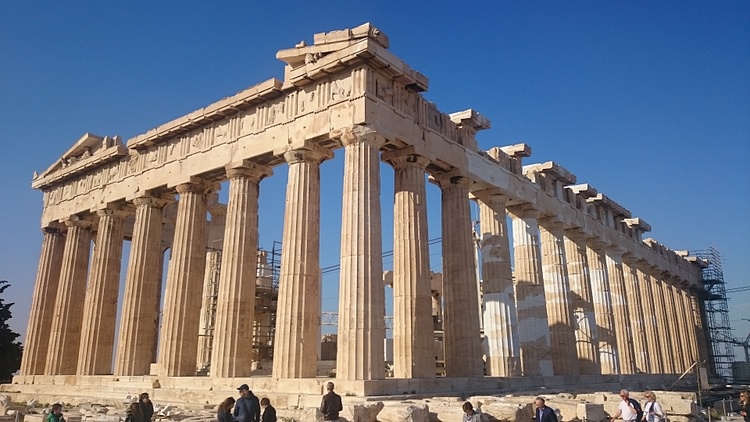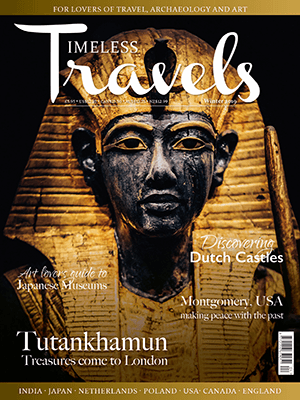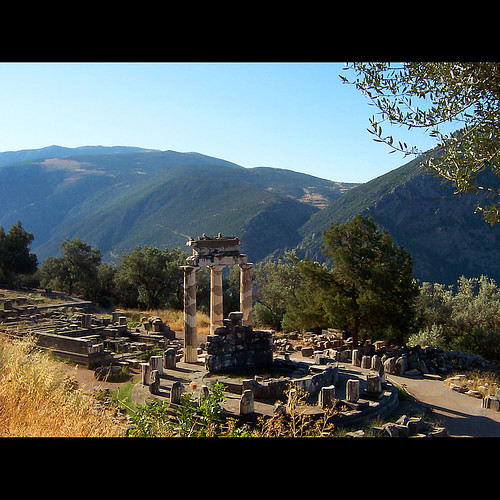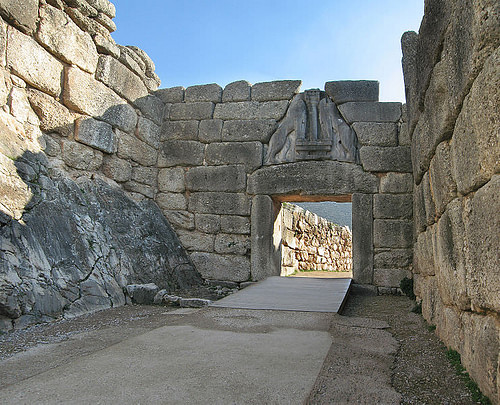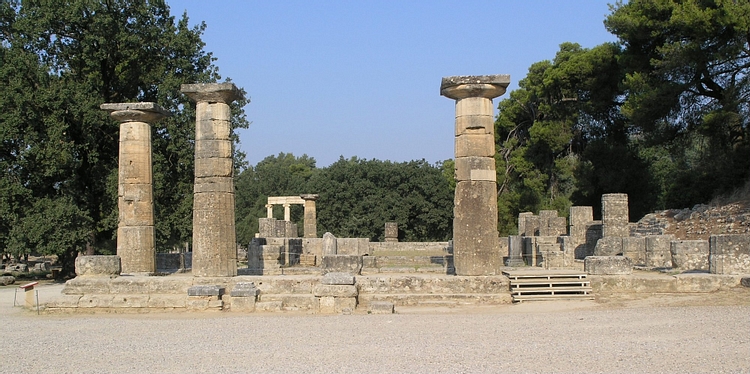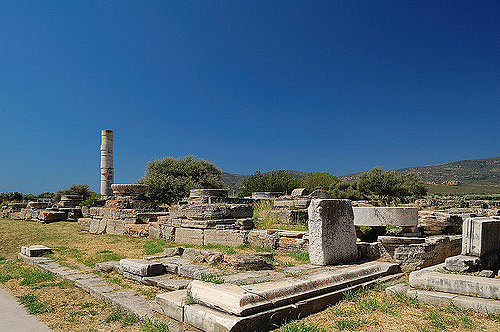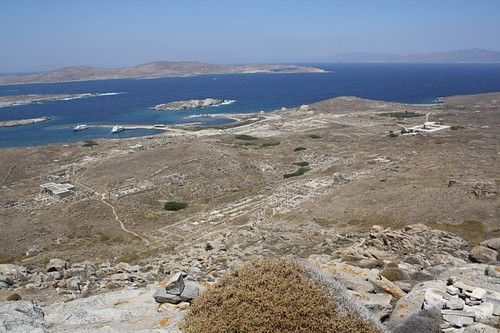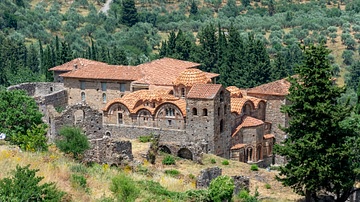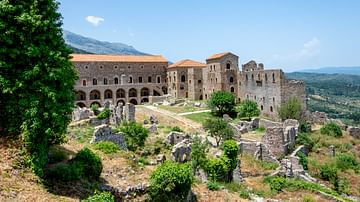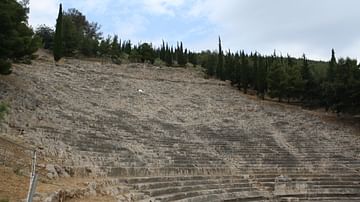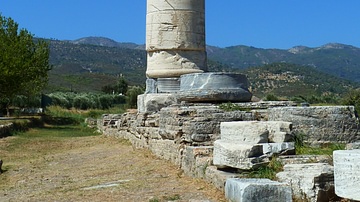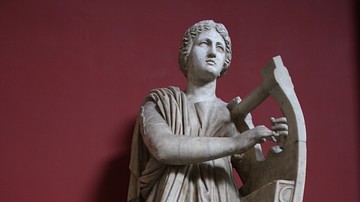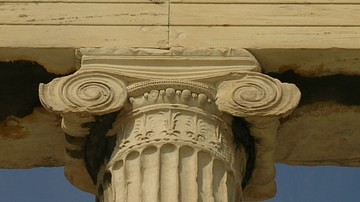Greece, the 'cradle of western civilization', is home to a large number of spectacular sites from the ancient world, several of which have been placed on the UNESCO World Heritage List. These sites of great historical importance, interest, beauty, and impact do not all reflect the civilization we call Classical Greece - they range from prehistoric citadels via Classical temples to Byzantine monasteries and beyond. Archaeologist Heinrich Hall has worked in Greece for over 20 years and gives his personal tips when visiting these extraordinary sites.
The Acropolis of Athens
The most obvious image of Greece and one of the most famous architectural monuments in the world, the Acropolis is the sacred rock that defines the heart of Athens. Settled since prehistory, it became the citadel of a Bronze Age (c. 3000-c.1200 BCE) realm in the 2nd millennium BCE and continued as a fortress in the Iron Age (c. 1200-c. 800 BCE). Eventually, the site was transformed into the formal religious centre of the Classical city. Its redesign after the famous Persian sack of 480 BCE, masterminded by the political leader Pericles and the artist Pheidias, began in 450 BCE when Athens was at the height of her wealth and power.
The main monuments then built include the awesome (in the true sense of the word) Propylaia, the ornate Temple of Nike, the highly original Erechtheion and - of course - the mighty Parthenon, the enormous shrine to Athena, the city's patron goddess. Today the Parthenon has become the most recognizable image of Greece and of ancient Greek architecture. A visit to the Acropolis should also include the many shrines and sanctuaries along its slopes and the state-of-the-art Acropolis Museum, with its wonderful collections devoted to Archaic and Classical art.
Heinrich's tip: Walk up to the northeast corner of the Parthenon and line up your eyes on a level with the steps of its foundation. If you look along those steps, you will spot the incredible optimal refinement of the building: all its straight lines are actually curved, meaning that no two blocks are quite the same shape.
Daphni, Osios Loukas & Delphi
Within easy reach of Athens are the UNESCO-listed monasteries at Daphni and Osios Loukas, both wonderful treasuries of Byzantine art. Daphni also has stunning mosaics, which have only recently reopened to the public after 16 years of renovations!
A little further from Athens, but reachable in an ambitious day trip or with a single overnight is the archaeological site of Delphi, the famous oracular sanctuary of Apollo. This is not just a World Heritage site, but also one of those evocative of all of antiquity's sacred places. Temples, treasuries, a theatre, and a stadium, all in a relentlessly lovely setting, make the visit unforgettable, along with a museum housing one of the finest collections of archaeological finds in the country.
The Archaeological Sites of Mycenae and Tiryns
These are the two best preserved of the great Mycenaean citadels surrounding the Plain of Argos. Linked with the mythology of the Homeric heroes and of Hercules, the quintessential hero of the Greek mainland, they were the incredibly well-defended centres of the palatial civilization we call Mycenaean, thriving between 1500 -1200 BCE. Their huge 'Cyclopean' walls, complex gates, underground cisterns, so-called palaces, enormous tombs in their vicinity and many other features make them first-rate sites, expressions of a still poorly-understood ancient culture.
To this day, their remains are jaw-droppingly monumental and highly evocative. However, it can be hard to understand these captivating sites without an expert guide who can bring them to life and help you understand their significance. Their interpretation can be helped by the superb accompanying museums at Nafplio and at Mycenae itself – because once again, it is not just the architectural remains that have a story to tell, but also the fascinating artefacts associated with them: jewellery, weaponry, painted vases, figurines, and frescoes.
Heinrich's tip: If you drop by Tiryns in late summer, you may come across the German (Heidelberg University) excavation team. If you ask nicely, they might show you what they're up to.
The Sanctuary of Asklepios at Epidaurus
Near the shores of the Saronic Gulf, the Sanctuary of Asklepios is a place renowned for its serene atmosphere. Known for its ancient amphitheatre the site is located in a particularly peaceful and verdant Mediterranean landscape with the scent of pine trees wafting across the site.
The amphitheatre is considered the most beautiful and most perfectly proportioned of its kind, creating a strong sense of focus, helped by the superb acoustics and an impression of harmony that belies its enormous size: it seats over 14,000. The remains of the nearby sanctuary, dedicated to Asklepios, the God of Healing, are also fascinating because they show the structure and functions of an ancient health resort.
Epidaurus is a soothing and refreshing place to visit, humbling and elevating at the same time. It is especially impressive during the summer festivals, when a series of plays (not all of them ancient) are staged at night, using no artificial amplification.
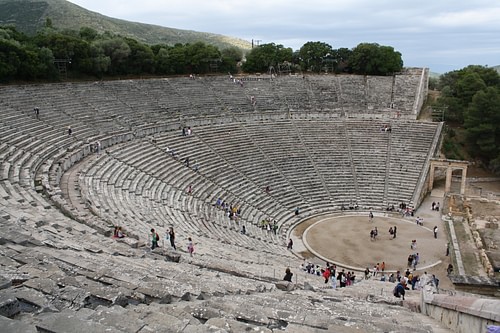
Heinrich's tip: guides do all kinds of things to demonstrate the amazing acoustics, such as clapping their hands, dropping a pin, striking a match and so on. Much more effective: stand on the top tier of seating (or sit) and make a friend standing in the middle of the circular orchestra simply say something in a low, casual voice!
The Archaeological Site of Olympia
One of antiquity's most famous places, Olympia, is the site of a major Pan-Hellenic (all-Greek) sanctuary dedicated to Zeus as well as it used to be the location of the original Olympic Games. Its remains, mostly from the 7th century BCE- 5th century CE, are extremely interesting to visit as they make it easy to imagine the place in its heydays- when thousands of spectators and athletes would flock to its groves every four years to celebrate the father of the gods and observe the competitions.
The monuments visible at Olympia include the famous Temple of Zeus, once home to the gold-and-ivory statue that was one of the Seven Wonders of the Ancient World, the venerable Temple of Hera, the bouleuterion or council chamber, an ancient hotel, the training facilities and - of course - the mother of all stadiums. The fact that all of the Greek World attended the Games meant that the participating city-states all tried to be visibly represented and commemorated on the site, making it a microcosm of ancient Greece.
The site also includes a superb museum, full of first-rate sculpture, weaponry, athletic equipment and much more, including the wonderful statue of Hermes by Praxiteles – one of the very few surviving pieces by one of the most famous ancient sculptors.
Heinrich's tip: To understand the sheer size of the Temple of Zeus, don't concentrate on the single re-erected column. Have your photo taken next to the fallen ones on the southern side – no scale is more effective than your own size!
The Temple of Apollo Epikourios at Bassae
This extraordinary and romantic monument is one of the least-visited World Heritage sites in the country, due to its remote location in the rugged mountains of Arcadia. The same remoteness has ensured its extraordinary preservation, comparable to the better-known Greek temples of Sicily, since it was never used as a quarry.
The modernist tent-like structure that currently covers the site to protect it from erosion adds to the strange and out-of-this-world atmosphere that prevails at this near-perfect example of a 5th-century BCE Doric edifice. Getting to Bassai entails a drive through some of the Peloponnese's most remarkable scenery and some of the region's famously beautiful mountain villages.
The Temple itself, typical at first sight, is actually full of peculiarities, such as its unusual orientation, the presence of a side entrance to its inner sanctum, the central placement of one of the oldest known Corinthian columns and much more. The temple also has a somewhat mysterious identity - that of Apollo Epidauros, the deity to whom it was dedicated.
Heinrich's tip: stay for a while and take in the atmosphere. If you have time, climb uphill from the Temple. After about 20 minutes you reach the summit of Mt. Kotilion, with fantastic views all around, and with the foundations of another temple, that to Apollo's sister, Artemis!
The Archaeological Site of Mystras
Mystras is one of Greece's Medieval marvels. Initially founded in 1249 by William of Villehardouin, who erected the fortress on the hilltop. The site, located near Sparta, became the Byzantine capital of the Peloponnese, in the 13th - 15th centuries CE, when it was a centre of thought, faith and art. Today, what is left of the once-busy town are the castle, the hulking Palace of the Despots, as well as numerous chapels, churches and monasteries, many of which are richly decorated with fresco paintings of the Palaiologan Period, the final flourish of Byzantine art before the fall of Constantinople (1453 CE). The site also offers wonderful views over the plain of the river Eurotas and modern day Sparta.
Heinrich's tip: Go early and climb up to the castle. Not everyone does it – but the views are superb!
The five World Heritage sites (Mycenae and Tiryns are listed as one) make exploring the Peloponnese one of the richest areas to explore, although Sicily still has the most World Heritage sites listed. This might change in the future, as the Venetian fortresses of Methoni and Nafplio, as well as ancient Messene, are considered possible contenders, which would push the Peloponnese to the top of the list.
The Early Christian & Byzantine Monuments
of Thessaloniki
These monuments are just one aspect of that truly fascinating and very lively city (one of the few large cities in Europe that can boast a main square open to the sea on one side) - but highly important ones. The city, founded about 315 BCE, became the main centre and port of Macedonia under the Romans and has remained so until the present day. The site was especially significant in Late Roman and Byzantine times when it was a seat of power, an economic hub and a place of fine art and architecture second only to Constantinople itself.
Key monuments include the Rotonda, originally built as a mausoleum to the Roman Emperor Galerius around 300 CE and later dedicated as a church of St. George; the 5th and 7th century CE enormous Basilica of St. Demetrios; the 5th century CE Church of the Virgin Acheiropoietos and the splendid 8th century CE Agia Sophia. The city also has excellent archaeological and Byzantine museums. Both of them contain stunning material from the region, presented in a very modern and visually highly effective exhibition style: the Gold of Macedon exhibit is truly world class!
Heinrich's tip: Don't miss out on the superb Late Roman and Byzantine city walls, especially the upper section with great panoramas of the city and the sea.
The Archaeological Site of Aigai
Ancient Aigai, better known by its modern name of Vergina, is one of the most spectacular visits on anyone's itinerary to Greece. The city was founded as the new capital of the Kingdom of Macedon by Philip II (r. 359-336 BCE)- father of Alexander the Great (r. 336-323 CE). When Philip was murdered there in 336 BCE, Alexander had him buried with lavish grave goods of jewellery, furniture and weaponry.
The mound covering Philip II's grave and a series of other royal tombs was discovered in the 1980s CE. The tombs showed to contain one of the world's most astonishing assemblages of archaeological treasure. It can now be experienced in an unbelievably well presented underground museum. The immense wealth expended on the king's funeral includes literally dozens of objects of unparalleled craftsmanship, such as Philip's golden funeral wreath, painstakingly imitating one of oak leaves.
Heinrich's tip: If you inquire about the other monuments at Aigai, the guards will show you the way to the ancient theatre. It is not far away. It isn't too well preserved, but it is the very spot where Philip was murdered. On the slope above it sit the foundations of his palace, which are slated to open for the public very soon!
Meteora
Meteora is one of Greece's best-known sites and perhaps its most picturesque. It is famous for its series of eremite monasteries, set in seemingly impossible locations on the tops of steep and tall rock pillars that overlook the fertile Plain of Thessaly. Monastic activity here began in the 11th century CE, but reached a peak of activity in the 14th - 16th centuries CE. In Meteora's heyday, there were 24 monasteries, of which four are still occupied. They are fascinating not just for their incredible setting, but also for the fine examples of 15th and 16th century CE fresco paintings preserved in the chapels and attendant buildings.
Heinrich's tip: also visit the prehistoric cave of Theopetra nearby.
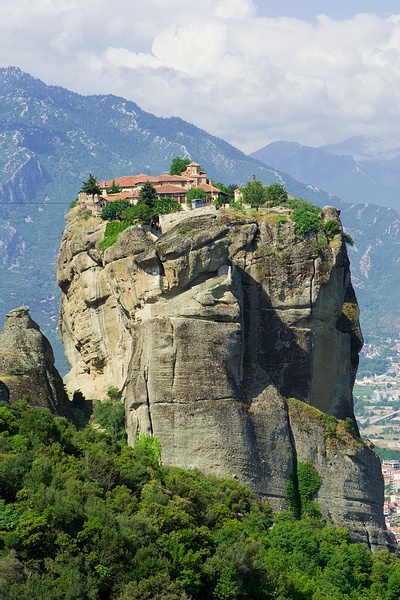
Pythagoreion & the Heraion of Samos
This double listing comprises one of Greece's most astounding archaeological landscapes, especially for remains of the 6th century BCE Archaic period, as already noted by Herodotus in the 5th century BCE.
Modern Pythagoreion occupies the site of ancient Samos city, with its huge harbour mole, massive walls and the amazing Tunnel of Eupalinos, a 1000 meter-long rock-cut channel that allowed an aqueduct to supply the city with water from the other side of a mountain. Certainly a masterpiece of very ancient Greek engineering and a milestone in the history of civil engineering!
The nearby Heraion, the birthplace of the Goddess Hera, sister and wife to Zeus, is now a remarkably atmospheric place set in a coastal swamp. Little remains of its once mighty Temple, one of the three great Ionian edifices, but the museum at Vathi is a veritable treasure trove, holding countless wonderful items excavated at the Heraion. Among them are the votive offerings from all over the Mediterranean and far beyond, as well as key specimens of archaic metalwork and ivory carving and a series of extraordinary colossal sculptures.
Heinrich's tip: The museum contains a vast amount of incredible fine votive offerings from many periods and places. Take your time and look at them in detail. My favourite piece is the ivory-carved figurine of a male dancer. From the 8th century BCE and probably made in Crete, it was once part of a musical instrument.
The Historic Centre (Chora) with the Monastery of Saint John the Theologian & the Cave of the Apocalypse on the Island of Patmos
This is a rich assemblage of medieval (and later) sites on that tiny Patmos. Patmos is the setting of the late 1st century CE vision described in the biblical Apocalypse, inspiring the great monastery founded in 1088 CE. Over time, the fortress-like main monastery, decorated with superb frescoes from the 12th century CE and later dates, gave rise to various further monasteries and hermitages throughout the island- including the one covering the cave where the vision is said to have taken place.
Later, from the 15th century CE onwards, an affluent town grew around the main monastery populated by refugees from now-Ottoman controlled Constantinople and later from Crete. Today's visitors, therefore, have a chance to admire not only a wonderfully convoluted example of Byzantine architecture and fresco decoration, but also the serene and impressive mansions of the labyrinthine Chora surrounding it.
Heinrich's tip: Don't just go to the monastery and leave. Take your time to stroll through the lanes of the Chora – sit for a coffee, and find the superb little archaeological museum.
The Medieval City of Rhodes
The capital of the largest island in the Dodecanese is a place of immense historical depth. Set upon the remains of an ancient Greek city founded in 408 BCE and its Roman and Byzantine continuation, the city as experienced today is essentially the creation of the Crusader Knights of Saint John. They took over the island in 1309 CE and controlled it, along with most of the Dodecanese, until 1522 CE. Its medieval streetscape, one of the most comprehensively preserved of its kind, is surrounded by a truly astonishing set of massive walls and moats of huge dimensions.
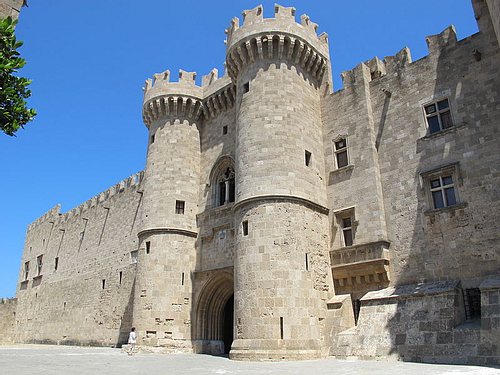
Inside the town stands a host of monuments, including various churches and chapels, the auberges or headquarters of the various tongues (branches) of the Knights, the Hospital of the Knights, now housing the Archaeological Museum, and the Palace of the Grand Masters with further exhibits.
Heinrich's tip: On a few occasions each year, the enormous walls can be walked for nearly their entire length. Find out when that is and time your visit accordingly if you can. If you can't, get away from the main tourist drag and explore the back lanes at leisure. At night, the square outside the Turkish Bath is a great place for a cool drink.
The Island of Delos
The tiny island of Delos, next to Mykonos in the Cyclades, is one of the most important archaeological sites anywhere in The Mediterranean. In Greek antiquity it was considered sacred and believed to be the birthplace of the god Apollo and his twin sister Artemis, making it a sanctuary of great appeal throughout the Greek World and beyond. The city-state of Athens especially developed a veritable obsession with Delos, embellishing it with fine monuments. Later, the island gained important tax privileges and became an immensely important centre of trade and one of the earliest major Roman settlements in the Aegean.
As a result of this history, Delos, which is uninhabited today, is nearly fully covered in archaeological remains, subject to excavation since more than a century ago. The visitor can stroll the lanes, streets and squares of ancient Delos, viewing its shrines and temples, shops and theatre, but also many of its fine residential homes with their architectural details and decorations. The excavations have also revealed an extraordinary wealth of astonishing finds, from household items to works of art, which are housed in the wonderful on-line museum.
Heinrich's tip: the finds from Delos include an unusually high proportion of erotica. They are not necessarily highlighted in the museum - so look out for them!
As you see there is a lot of World Heritage to be discovered, enjoyed, explored and admired in Greece. You can travel with Heinrich around the sites in Greece, as he is an expert guide for Peter Sommer Travels. For more information, see https://www.petersommer.com/greece/tours
